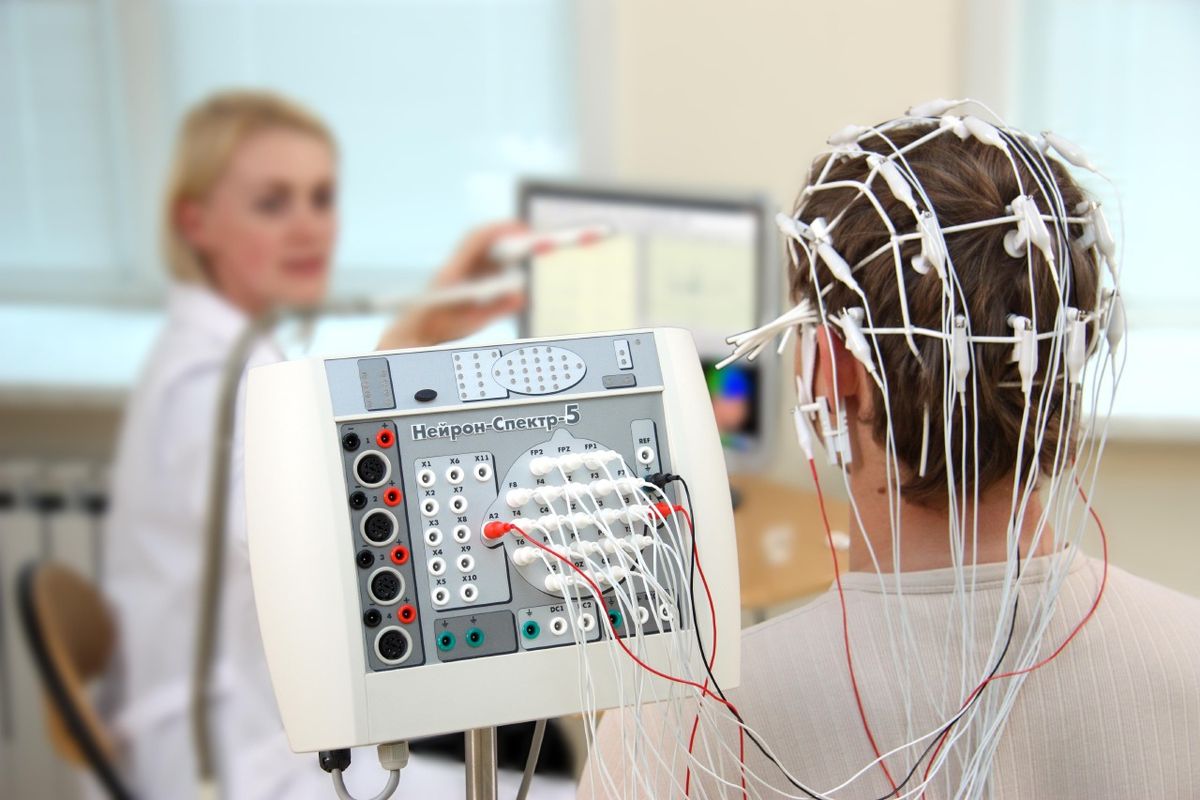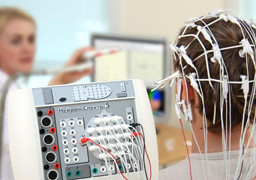мқёк°„мқҳ л‘җлҮҢлҘј мқҪлҠ” лёҢл Ҳмқё мҶҢмӢұ мқёкіөм§ҖлҠҘ(AI) м•Ңкі лҰ¬мҰҳ
мөңк·ј 2020л…„ м»ҙн“ЁнҢ… мӢңмҠӨн…ң лӮҙ мқём Ғ мҡ”мқё(Human Factors in Computing Systems)м—җ кҙҖн•ң ACM м»ЁнҚјлҹ°мҠӨ(the ACM Conference)м—җм„ң н—¬мӢұнӮӨ лҢҖн•ҷмқҳ м—°кө¬мӣҗл“ӨмқҖ мӮ¬лһҢл“Өмқҳ лҮҢ нҷңлҸҷмқ„ мӮ¬мҡ©н•ҳм—¬ мқҳкІ¬мқ„ 분м„қн•ҳкі кІ°лЎ мқ„ лҸ„м¶ңн•ҳлҠ” лҚ° мқёкіөм§ҖлҠҘмқ„ нҷңмҡ©н•ҳлҠ” кё°мҲ м—җ лҢҖн•ҙ м„ӨлӘ…н–ҲлӢӨ. м—°кө¬мӣҗл“Өмқҙ вҖҳлёҢл Ҳмқё мҶҢмӢұ(brain sourcing)вҖҷмңјлЎң л¶ҖлҘҙлҠ” мқҙ кё°мҲ мқҖ мқҙлҜём§ҖлҘј 분лҘҳн•ҳкұ°лӮҳ мҪҳн…җмё лҘј 추мІңн•ҳлҠ” лҚ° мӮ¬мҡ©лҗ мҲҳ мһҲлҠ”лҚ°, мқҙкІғмқҖ мқҙм „м—җлҠ” мһ…мҰқлҗҳм§Җ м•Ҡм•ҳлҚҳ мҳҒм—ӯмқҙлӢӨ.
н—¬мӢұнӮӨ лҢҖн•ҷмқҳ м—°кө¬мӣҗл“ӨмқҖ мқёкіөм§ҖлҠҘ кё°мҲ мқҳ лҸ„мӣҖмқ„ л°ӣм•„ мӮ¬лһҢл“Өмқҳ лҮҢнҢҢ(electroencephalograms, EEG)лҘј 분м„қ н• мҲҳ мһҲлҠ” к°ҖлҠҘм„ұмқ„ мӢӨн—ҳн–ҲлӢӨ.
м—°кө¬мӣҗл“ӨмқҖ нӮӨліҙл“ңлӮҳ л§Ҳмҡ°мҠӨлЎң мҲҳмһ‘м—…мқ„ мҲҳн–үн•ҳм§Җ м•Ҡкі вҖҳмқҙлҜём§Җм—җ лҢҖн•ң мӮ¬лһҢл“Өмқҳ л°ҳмқ‘мқ„ мҲҳ집н•ҳлҠ” кІғвҖҷмқҙ мқёк°„мқҳ мһҗм—°мҠӨлҹ¬мҡҙ л°ҳмқ‘мқ„ нҷңмҡ©н•ҳм—¬ мқҙлҜём§Җ мқёмӢқм—җ м Ғмҡ©лҗ мҲҳ мһҲлҠ”м§ҖлҘј мЎ°мӮ¬н•ҳкі мһҗ н–ҲлӢӨ. лҚ°мқҙн„°м—җ лҢҖн•ң мӮ¬лһҢл“Өмқҳ н•ҙм„қмқ„ л¬јмқҢмңјлЎңмҚЁ мқёкіөм§ҖлҠҘ мӢңмҠӨн…ңмқ„ нӣҲл ЁмӢңнӮӨкё° мӢңмһ‘н•ҳлҠ” лҢҖмӢ , мқҙ м •ліҙлҠ” лҮҢм „лҸ„лЎңл¶Җн„° м§Ғм ‘ мқҪнҳҖм§Ҳ мҲҳ мһҲм—ҲлӢӨ.
мқҙ м—°кө¬м—җм„ң мҙқ 30лӘ…мқҳ м°ёк°Җмһҗл“ӨмқҖ м»ҙн“Ён„° нҷ”л©ҙ мғҒм—җм„ң мӮ¬лһҢл“Өмқҳ м–јкөҙ мқҙлҜём§Җл“Өмқ„ ліҙкі , к·ё мқҙлҜём§ҖлҘј л°”нғ•мңјлЎң к°Ғмһҗмқҳ л§ҲмқҢм—җ к·ё м–јкөҙл“Өмқ„ м§Җм •н•ҳлҸ„лЎқ(label) м§ҖмӢң л°ӣм•ҳлӢӨ. мҳҲлҘј л“Өм–ҙ, мқҙлҜём§Җм—җ лӮҳмҳЁ мӮ¬лһҢмқҙ кёҲл°ңмқём§Җ кІҖмқҖ лЁёлҰ¬мқём§Җ, мӣғлҠ”м§Җ мӣғм§Җ м•ҠлҠ” м§Җ л“ұмқҙ к·ёкІғмқҙлӢӨ. мқҙ мӢӨн—ҳмқҖ кё°мЎҙмқҳ нҒ¬лқјмҡ°л“ң мҶҢмӢұ лҚ°мқҙн„° мҲҳ집과 лӢ¬лҰ¬ м°ёк°Җмһҗл“ӨмқҖ л§Ҳмҡ°мҠӨлӮҳ нӮӨліҙл“ңлҘј мӮ¬мҡ©н•ҳм—¬ 추к°Җ м •ліҙлҘј м–»мқ„ мҲҳ м—Ҷкі лӢЁмҲңнһҲ м ңмӢңлҗң мқҙлҜём§ҖлҘј кҙҖм°°н•ҳлҠ” кІғмқҙм—ҲлӢӨ.
лҸҷмӢңм—җ, к°Ғ м°ёк°Җмһҗл“Өмқҳ лҮҢ нҷңлҸҷмқҙ лҮҢнҢҢ кё°лЎқмқ„ нҶөн•ҙ мҲҳ집лҗҳм—ҲлӢӨ. мқҙ лҮҢнҢҢлЎңл¶Җн„° мқёкіөм§ҖлҠҘ м•Ңкі лҰ¬мҰҳмқҖ кёҲл°ңмқё мӮ¬лһҢмқҳ мқҙлҜём§Җк°Җ нҷ”л©ҙм—җ лӮҳнғҖлӮ л•ҢмҷҖ к°ҷмқҙ н•ҙлӢ№ мһ‘м—…кіј кҙҖл Ёлҗң мқҙлҜём§ҖлҘј мқёмӢқн•ҳлҠ” л°©лІ•мқ„ н•ҷмҠөн–ҲлӢӨ.
мӢӨн—ҳ кІ°кіј, м»ҙн“Ён„°лҠ” лҮҢнҢҢм—җм„ң м§Ғм ‘ мқҙлҹ¬н•ң л©ҳнғҲ лқјлІЁ(mental label)мқ„ н•ҙм„қн• мҲҳ мһҲм—ҲлӢӨ. м—°кө¬мӣҗл“ӨмқҖ мқҙлҹ¬н•ң лҮҢнҢҢ кІ°кіјлҘј л§Өмҡ° мӢ лў°лҸ„ лҶ’мқҖ лқјлІЁл§Ғ кІ°кіј – 12лӘ…мқҳ мһҗмӣҗмһҗлЎңл¶Җн„° мҲҳ집лҗң лҚ°мқҙн„°лҘј мӮ¬мҡ©н•ҳм—¬ мқҙлҜё мһ…мҰқлҗң - мҷҖ 비көҗн•ң нӣ„, вҖҳлёҢл Ҳмқё мҶҢмӢұвҖҷмқҙ к°„лӢЁн•ҳкі мһҳ м •мқҳлҗң мқёмӢқ мһ‘м—…(recognition tasks)м—җ м Ғмҡ©лҗ мҲҳ мһҲлӢӨкі кІ°лЎ м§Җм—ҲлӢӨ.

лӢЁмҲңнһҲ мқёкіөм§ҖлҠҘ мӢңмҠӨн…ңмқ„ н•ҷмҠөмӢңнӮӨлҠ” кІғмқ„ л„ҳм–ҙ, мқҙлҹ¬н•ң л°ңкІ¬мқҖ л‘җлҮҢмҷҖ м»ҙн“Ён„° нҷңлҸҷмқ„ кІ°н•©н•ҳлҠ” лӢӨм–‘н•ң мқён„°нҺҳмқҙмҠӨлҘј к°ңм„ н•ҳлҠ” лҚ° нҷңмҡ©лҗ мҲҳ мһҲлӢӨ. мқҙлҹ¬н•ң мқён„°нҺҳмқҙмҠӨлҠ” мӣЁм–ҙлҹ¬лё”(wearable) м „мһҗ мһҘм№ҳмқҳ нҳ•нғңлЎң к°ҖліҚкі мӮ¬мҡ©мһҗ м№ңнҷ”м Ғмқё лҮҢнҢҢ мһҘм№ҳмқҳ мӮ¬мҡ©мқ„ н•„мҡ”лЎң н• кІғмқҙлӢӨ. мқҙлҹ¬н•ң кІҪлҹү мӣЁм–ҙлҹ¬лё” кё°кё°л“ӨмқҖ нҳ„мһ¬ нҷңл°ңн•ҳкІҢ к°ңл°ңлҗҳкі мһҲмңјл©° к°Җк№Ңмҡҙ мһҘлһҳм—җ м¶ңмӢңлҗ мҲҳ мһҲлӢӨ.
лҮҢ мқҙлҜём§Җ кё°мҲ мқҙ л°ңм „н•Ём—җ л”°лқј лҮҢм—җм„ң м§Ғм ‘ м„ нҳё(preference) м •ліҙлҘј нҸ¬м°©н•ҳлҠ” кІғмқҙ к°ҖлҠҘ н•ҙм§Ҳ кІғмқҙлӢӨ. л”°лқјм„ң кё°мЎҙмқҳ лІ„нҠјмқ„ мӮ¬мҡ©н•ҳм§Җ м•Ҡкі лҸ„, к°Ғ к°ңмқёл“ӨмқҖ лӢЁмҲңнһҲ л…ёлһҳлҘј л“Јкұ°лӮҳ мҮј н”„лЎңк·ёлһЁмқ„ ліј мҲҳ мһҲмқ„ кІғмқҙлӢӨ. лҮҢл§ҢмңјлЎңлҸ„ мқҙлҹ¬н•ң нҷңлҸҷмқ„ кІ°м •н• мҲҳ мһҲлҠ” кІғмқҙлӢӨ.
- ACM Conference on Human Factors in Computing Systems, April 2020, вҖңBrainsourcing: Crowdsourcing Recognition Tasks via Collaborative Brain-Computer Interfacing,вҖқ by Keith M. Davis, et al. ©ACM, Inc. All rights reserved.
To view or purchase this article, please visit:
https://dl.acm.org/doi/10.1145/3313831.3376288
Recently at the ACM Conference on Human Factors in Computing Systems, 2020, Researchers at the University of Helsinki explained a technique they have developed, using artificial intelligence, to analyze opinions, and draw conclusions using the brain activity of groups of people. This technique, which the researchers call вҖңbrain sourcing,вҖқ can be used to classify images or recommend content, something that has not been demonstrated before.
The University of Helsinki researchers experimented with the possibility of analyzing peopleвҖҷs electroencephalograms (or EEGs) with the help of AI techniques.
Why? They wanted to investigate whether collecting peopleвҖҷs reactions to images could be applied to image recognition by utilizing the natural reactions of people without them having to carry out any manual tasks with a keyboard or mouse. And then rather than beginning to train an AI system by asking for peopleвҖҷs interpretation of data, this information could be read directly from their EEGs.
In the study, a total of 30 volunteers were shown images of human faces on a computer display. The participants were instructed to label the faces in their minds based on what was portrayed in the images. For example, whether an image portrayed a blond or dark-haired individual, or a person smiling or not smiling. Unlike in conventional crowdsourced data collection, the volunteers did not provide any additional information using the mouse or keyboard, they simply observed the images presented to them.
Meanwhile, the brain activity of each participant was collected using electroencephalography. From the EEGs, the AI algorithm learned to recognize images relevant to the task, such as when an image of a blond person appeared on-screen.
In the results of the experiment, the computer was able to interpret these mental labels directly from the EEG. The researchers concluded that brain sourcing can be applied to simple and well-defined recognition tasks by comparing the EEG results with highly reliable labeling results which were already achieved using data collected from 12 volunteers.
Beyond simply training AI systems, the findings can be utilized to improve various interfaces that combine brain and computer activity. These interfaces would require the availability of lightweight and user-friendly EEG equipment in the form of wearable electronics. Such, lightweight wearables are actively being developed and may be available sometime in the near future.
As brain imaging technologies improve, it should become possible to capture preference information directly from the brain. So, instead of using conventional buttons, individuals could simply listen to a song or watch a show, and their brain activity alone would be enough to determine their response to it.
References
ACM Conference on Human Factors in Computing Systems, April 2020, вҖңBrainsourcing: Crowdsourcing Recognition Tasks via Collaborative Brain-Computer Interfacing,вҖқ by Keith M. Davis, et al. ©ACM, Inc. All rights reserved.
To view or purchase this article, please visit:
https://dl.acm.org/doi/10.1145/3313831.3376288








